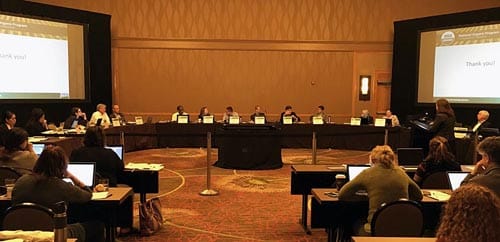Last Updated: April 21, 2017 at 1:45PM CT
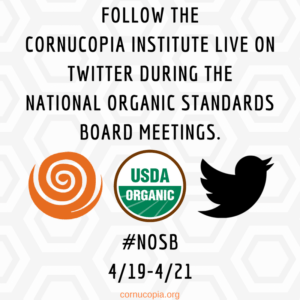 Join The Cornucopia Institute as we live tweet from the National Organic Standards Board meeting in Denver, Colorado. We will be sharing the play by play with our Twitter followers under #NOSB or simply follow our stream.
Join The Cornucopia Institute as we live tweet from the National Organic Standards Board meeting in Denver, Colorado. We will be sharing the play by play with our Twitter followers under #NOSB or simply follow our stream.
For background on issues up for discussion at the meeting, see:
- The Cornucopia Institute’s written public comments to the NOSB
- A summary of public comments at the NOSB’s pre-meeting webinar
- A recap of public comments from the non-profit community on NOSB issues
- A scorecard rating NOSB member voting records on contentious organic issues
You can also stay updated throughout the meeting right here:
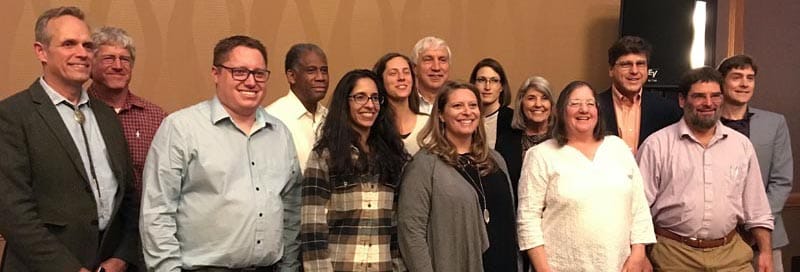 |
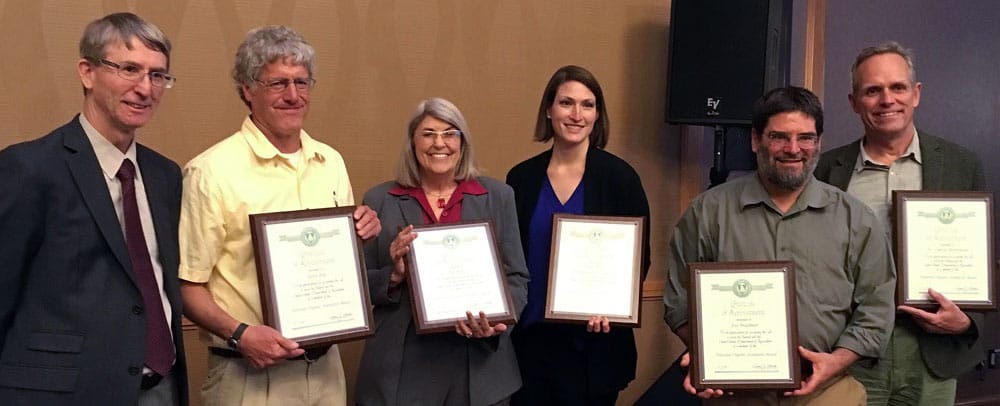 |
The five new members of the NOSB will serve five year terms on the 15-member NOSB.
Friday, April 21, 2017
1:35PM CT: The NOSB meeting is closed after each subcommittee reviewed their upcoming workplans (linked to from this page) and including a discussion document for organic seed purity from GMOs in the fall.
1:22PM CT: Moving onto other issues, the NOSB, by unanimous vote, passes a resolution urging the Secretary to allow the Organic Livestock and Poultry Practices rule to become effective on May 19, 2017 without further delay. Congress and the Secretary shouldn’t see this rule as a political issue because farmers and consumers represent the full spectrum of political lines.
1:00PM CT: Francis Thicke continues: I found a paper that compared the diversity between organic vs. conventional soils. I’m thinking that there will be a very different complexity between soils and container diversity. In many cultures there is a life force in the food. “The footstep of the farmer is the best fertilizer.” Science is showing there is more complexity than we thought.
Jesse Buie (farmer): We’ve done a lot of talking, but we understand the challenges and we understand the impact that this will have on the community. We need to move forward on a decision.
Steve Ela (farmer): The definitions may provide process but not clarity because we thought we had definitions this time.
Harriet Behar (environmentalist): Everything that is on the agenda feeds into this discussion. We are not in a vacuum. The rest of the world has standards we can follow on these issues.
Dan Seitz (consumer): I am hopeful about this process and our ability to reach compromise, which sometimes means lose/lose. Maybe Congress should watch the organic program.
Francis (jokingly): Remember we sunsetted 11 inputs last fall. That means we can make five and a half new regulations.
Asa Bradman (environmentalist): I’ve read every public comment that has come in. I have the task force report in front of me. I would appreciate if Driscoll’s and Wholesum Harvest would come forward with a very clear description of their systems.
12:48PM CT: Emily Oakely (farmer) continues with the hydroponic discussion: Stakeholders on all ends of the spectrum do not want us to delay a decision on this because we will create more conflict within the community. In the fall, we need to put forward a proposal on what we can agree on.
The farmers are on the farm and not present at this meeting, so I feel the weight of representing the perhaps 75% of organic farmers that are small scale. Many people come to farming because it is both a business and a cause. Organics was a hippy-back-to-the-land movement, and now it encompasses a wide spectrum.
I’m under no illusion that the organic food at the grocery store comes from a five acre farm, but I want to see the standard applied equally to all stakeholders. My expectation is that the soil will provide the fertility. Outside sources are provided on an as-needed basis. I can’t imagine a soil system where an input is required for the survival of the crop.
Inputs are harvested or mined off farm. In hydroponics, rather than supplementation, the inputs are the complete system. To move forward we have to find middle ground.
Ashley Swaffar: I can’t vote on a hydroponic proposal without a container proposal too. If we move forward on any definition, I need to feel like containers are safe.
Francis Thicke (environmentalist) : Keep in mind we did have a container discussion last fall.
12:40PM CT: Lisa de Lima (retailer): In response to the label idea, it seems too nuanced, and you would have to apply the same nuance to all types of farms.
Ashley Swaffar: When we ask to see farms, we don’t want to go the day before the meeting. We need to go much before that so we can form definitions.
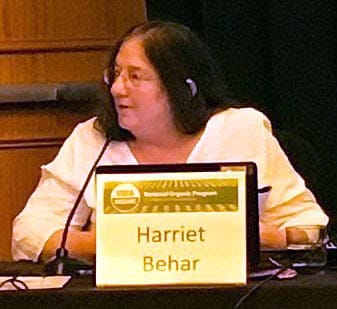 |
12:34PM CT: Harriet Behar (environmentalist): Organic is not input substitution. It is a whole system. It is about the environment, healthy food, a type of agriculture that offers hope for fixing the problems that we already have for seven generations and beyond.
Organic inspector for 20 years. When I ask farmers initially why they went from conventional farming to organic, they say a family member has cancer. When I go back a few years later, there was more to it. They saw biodiversity on the farm, they saw a healthier herd. The farmers don’t want to go back to conventional production, even if they lose the higher price.
The NOP wants us to justify a regulation that affects economic factors, so we will have to look at that. We should also be careful of caving to “innovation” because I have been in these meetings a long time and I’ve seen Monsanto testify about the innovations that GMOs can bring to organics, for example.
I grow in compost/soil containers with clover. It wouldn’t put me out of business if I couldn’t grow in containers, but I believe my system is organic. We could regulate this with a label “Hydroponic, made with organically approved inputs.”
12:21PM CT: Joelle Mosso (handler): When does something stop being what it is and start being something else? It is not a discrete line. I think we talk in circles because we do not have the same definitions.
Hydroponic to me might mean something different to you. One thing we all have in common is that we can’t make decisions on something we don’t understand. Organic has been ecological and sustainable and healthy. Accessibility is something I’m concerned about.
I want organic to be the form of agriculture, not a subset of agriculture. If we get rid of hydroponic, whatever that means to you, that will inevitably introduce another label. In 50 years I don’t want to look back at this decision and think “we just didn’t understand.”
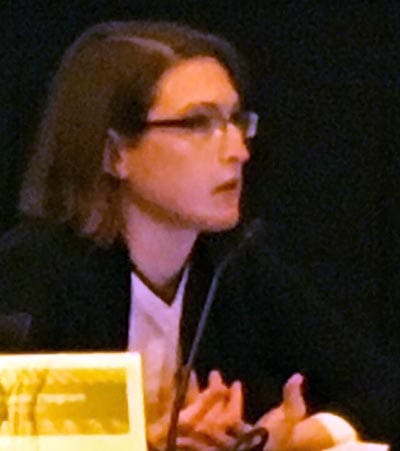 |
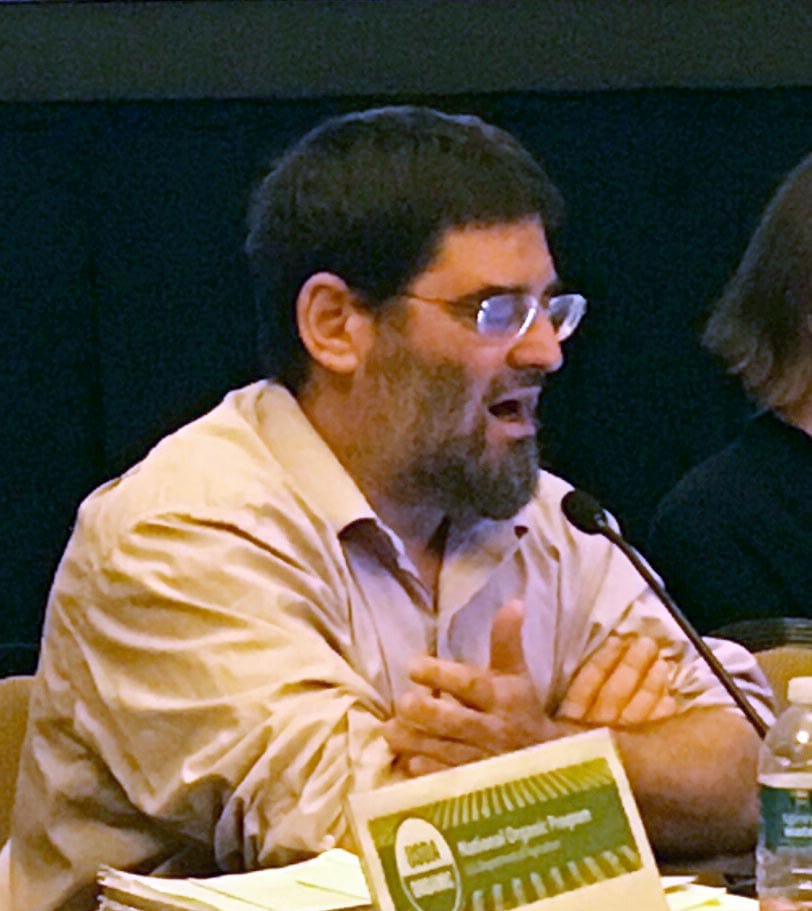 |
Asa Bradman (environmentalist): I’ve seen hydroponic systems that appear to be in line with organic. I’m humbled to be on this board and making decisions that affect people’s living. We need more stakeholders in this.
Perhaps we need a forum on this. Process is important. I tend not to want to prohibit things. I want to describe what we are for.
12:13PM CT: Scott Rice (certifier): I represent a diverse stakeholder group. I’ve seen so many different operations and have expanded my views of what can be organic. From a certifier standpoint.
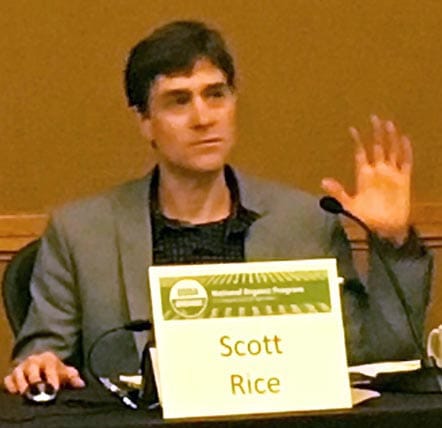 |
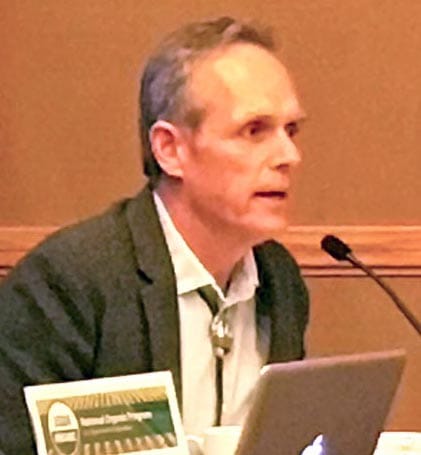 |
Dave Mortensen (scientist): There’s a credibility problem in science today. While scientists are incredibly objective about their methods, they are subjective of the questions that they ask. Very few people ask why are we asking these questions and not others. As a group we need to be asking the right questions.
In my view as an agroecologist and ecotoxicologist, what’s the ecological footprint of the practices? How resilient are the systems? What are the ecoservice implications? I understand food deserts. I understand different communities and points of view. We must create space for conversation and that means together, face-to-face. We need to get out and see these operations.
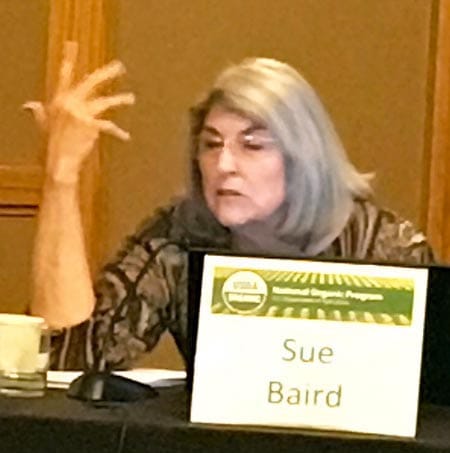 |
12:05PM CT: Sue Baird (consumer/public interest): I’m confused and influenced on this daily. I feel strongly that we must not leave small family farms out of organic.
12:00PM CT: Tom Chapman (handler – Clif Bar) does not want the outcome to be another label. He’s already seen confusion with the non-GMO label. Any compromises in this decision cannot compromise consumer trust in the label. Reductionist arguments will not move this decision forward. The law says organics is about the soil, but it also says it is about inputs. I don’t recommend a timeline, but these issues need to be discussed in depth.
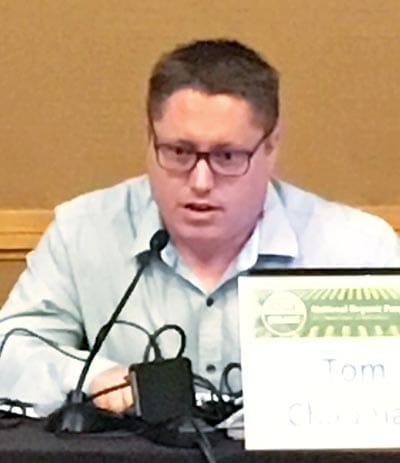 |
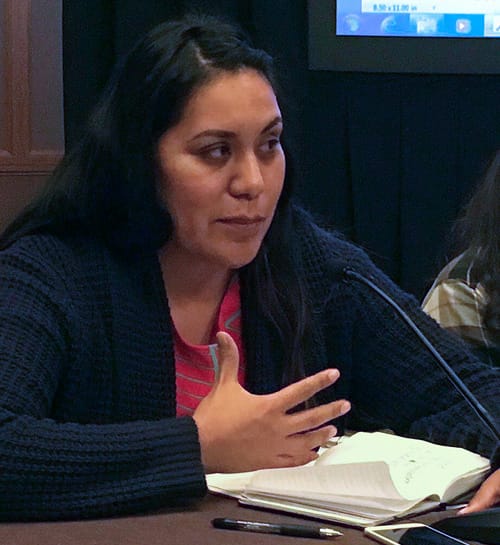 |
11:57AM CT: A-dae Briones (consumer/public interest) points out that from a native peoples’ perspective, when we look at legal systems, there are biases in the law.
Unfortunately, there is a whole class of people that don’t have access to land in this country. Our success as a people is tied to the land, but in Hawaii there are systems that are old and innovative and can meet what we think of as organic and sustainable. This is such an important decision that the process needs to include all the board.
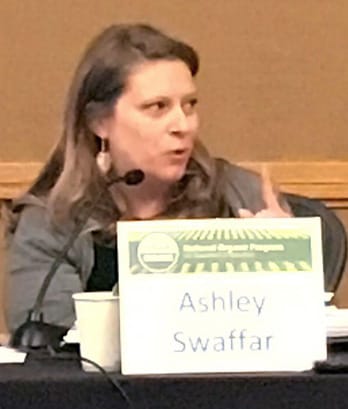 |
11:45AM CT: Ashley Swaffar: “I would like to see another discussion on this and, at the earliest, a vote on this next spring.”
I really would like to see a container discussion document come forward and be voted on at the same time as the vote on definitions.
Cornucopia Note: Cornucopia would like to see a vote on this issue because the law is clear that fostering soil fertility is required.
11:42AM CT: Lisa de Lima (retailer): Currently this isn’t a question I hear a lot in the store – “Is this hydroponic?”
I’m torn by the environmental issues that this issue affects, as well as the desire to “grow organics.”
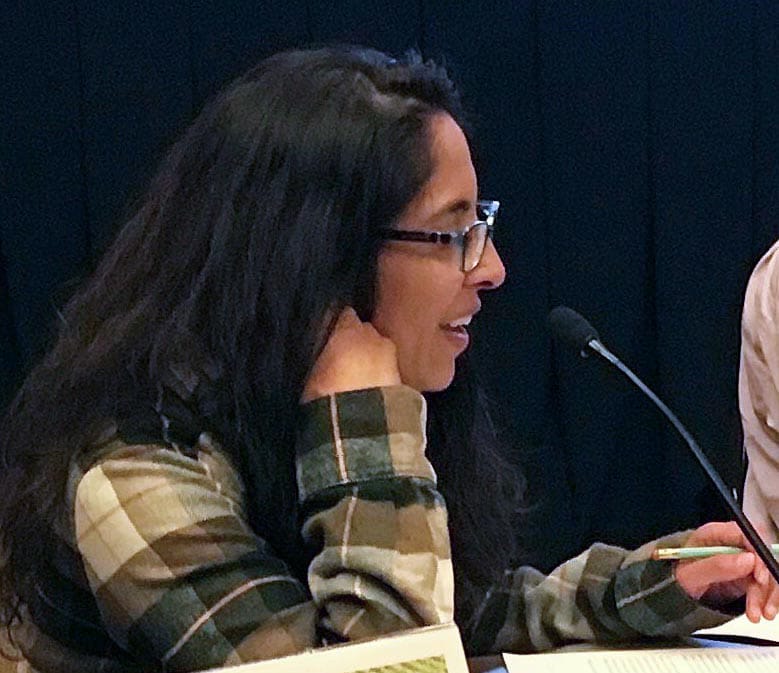 |
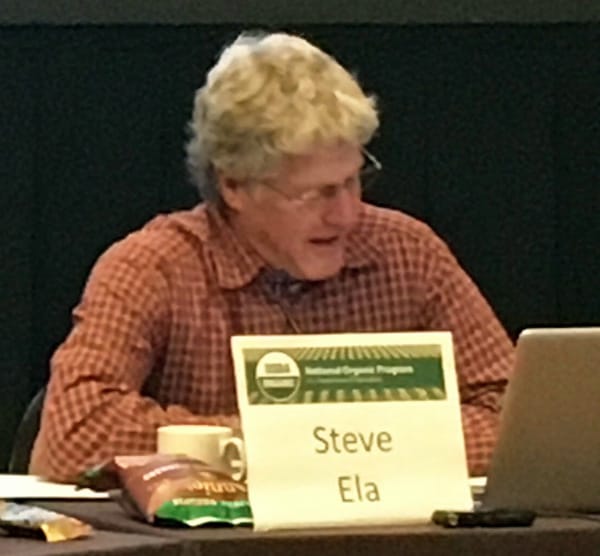 |
11:39AM CT: Steve Ela: I take literally that the producer must improve soil, water and natural resources.
We need to move beyond the biology – biology happens everywhere. We need multiple trophic levels. Do we have nematodes, fungi, and mammals, as well as bacteria?
An organic system should sustain itself with less human input, not more human input. If you remove everything but water, how long will that system maintain itself? I’ve grown for 15 years, and I understand the older I get the less I know.
I try to keep my hands off of the system unless there is something catastrophic – for me that would be codling moth. We need to foster natural systems as much as possible. I fall on the side of human hubris. I don’t think we can reliably engineer a natural system.
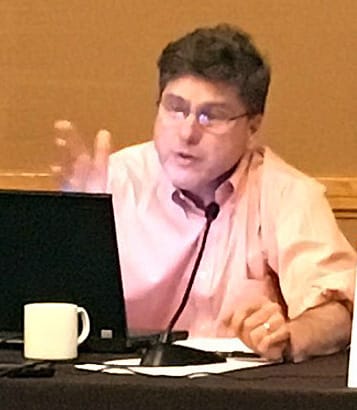 |
11:33AM CT: The NOSB members enter a long discussion where each are bringing different points to the table.
Dan Seitz: As a consumer representative on the board, consumers are schizophrenic. They want cheap food, nutritious food, year-round food. So it is going to be difficult to base this decision on them.
This issue gets at the heart of two basic conflicting paradigms: the mechanistic paradigm where humans have the capacity to improve the human condition indefinitely; and the natural paradigm where we should mimic natural systems with minimal influence.
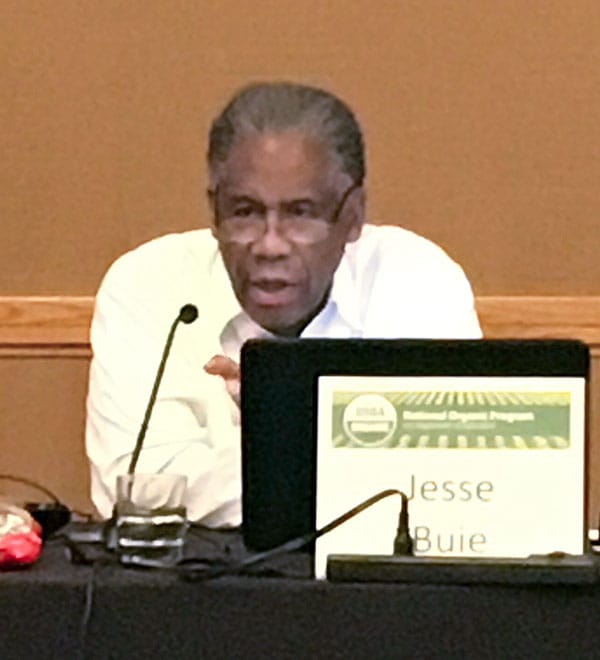 |
11:28AM CT: Jesse Buie: “We need to determine whether or not these systems meet the organic standards already in place, and not their own standards. How we get there is the question. As a board we need to come up with a consensus.”
11:16AM CT: The current discussion document is set up so that there will ultimately be six votes when it becomes a proposal: one vote each on separate definitions of aeroponics, aquaponics, and hydroponics, and then one vote each on whether each system is allowed.
11:09AM CT: The Crops Subcommittee opens the discussion of the aeroponic/hydroponic/aquaponic discussion document. At the fall 2016 NOSB meeting, the NOSB did not vote on the “Bioponics” proposal, but voted to send it back to the Crops Subcommittee for further work.
However, last fall the NOSB did pass the following statement in a resolution: “It is the consensus of the current members of the NOSB to prohibit hydroponic systems that have an entirely water based substrate.”
Farmer member Emily Oakley and environmentalist member Francis Thicke opposed the resolution because they preferred that it include the following wording: “…it is the consensus of the current members of the NOSB to prohibit hydroponic systems that have an entirely water based substrate or are wholly dependent on liquid fertility inputs.”
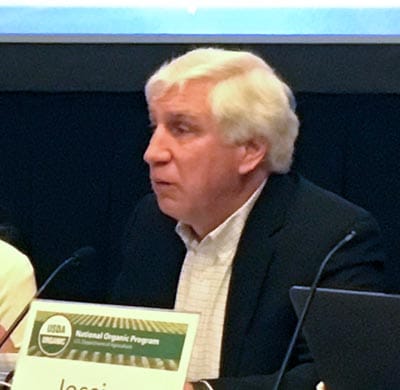 |
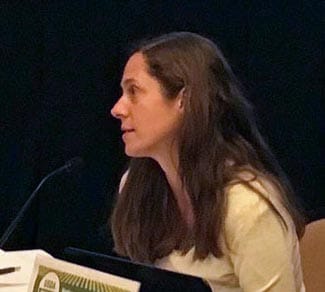 |
The discussion document at this meeting has suggested language for a definition of hydroponics: The production of normally terrestrial, vascular plants in nutrient-rich solutions, or in a medium of inert or biologically recalcitrant solid materials to which a nutrient solution is added.
The term “recalcitrant” is used by soil scientists to describe organic materials that are resistant to microbial degradation, but will degrade slowly over time. Today, plant-based materials – like coconut coir, wood shavings, and peat – are often used in place of inert materials for the solid matrix for hydroponics because they do not readily degrade (biologically recalcitrant).
10:44AM CT: The seed proposal, sent back to subcommittee, leaves the NOSB with two possible avenues, either to seek a rule change to the seed practice standard § 205.204, requiring an improvement over time until 100% organic seed use is achieved, or to work at strengthening the guidance NOP 5029.
These are not mutually exclusive; while waiting for a proposed rule change, the guidance could be strengthened as well. The issue becomes whether the NOSB should propose a rule change or not.
10:40AM CT: After discussing stronger rules requiring the use of organic seed, the proposal was sent back to the subcommittee for further study.
10:17AM CT: A long discussion by the NOSB on humic acids. They do not provide additional nutrients to plants, but rather affect soil fertility by making micronutrients more readily available to plants. Humic acids are applied as a soil conditioner to increase cation exchange capacity, enhance mineral availability, improve soil structure, stimulate soil microorganisms, and provide broad spectrum trace elements.
Humic acids are manufactured from oxidized lignite and are derived from leonardite, lignite, or coal. Extracts from non-synthetic humates by hydrolysis using synthetic or non-synthetic alkaline materials are permitted, including the use of potassium hydroxide and ammonium hydroxide.
Humic acid derivatives are on the National List with the following annotation: naturally occurring deposits, water and alkali extracts only. There is concern that they are overused instead of employing production practices like cover cropping and composting. But they are also a good tool for farms transitioning to organic that haven’t increased their soil organic matter.
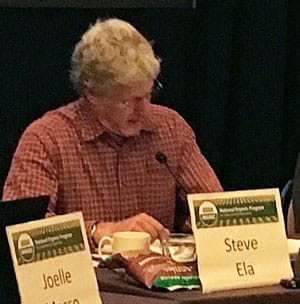 |
(farmer) leads copper discussion |
10:06AM CT: Crops Subcommittee discusses fixed coppers and copper sulfate for disease control, especially for tree fruits, since antibiotics are no longer allowed to be used for fire blight control.
Cornucopia supported the relisting of copper products as “restricted use” materials, provided that they are used in a manner that minimizes copper accumulation in the soil, and with the added annotation: no visible residue is allowed on harvested crops, and use needs to document multiple alternative attempts to control target, including in-field diversity.
Cornucopia expressed concern that monoculture plantings should use greater in-field biodiversity and wider plant spacing to reduce the dependency on regular copper sprays.
9:58AM CT: The Crops Subcommittee next discusses biodegradable plastic mulch. There are no products that meet the 100% biobased requirement of the weed control product “biodegradable biobased mulch films.”
This creates confusion to have it on the National List of approved materials for use in organics when it is not available. But it also creates an incentive in the industry to meet the 100% biobased requirement.
A new Technical Review has been received, and the NOSB hopes more research will be available about the breakdown products and effect on the soil as it biodegrades over time.
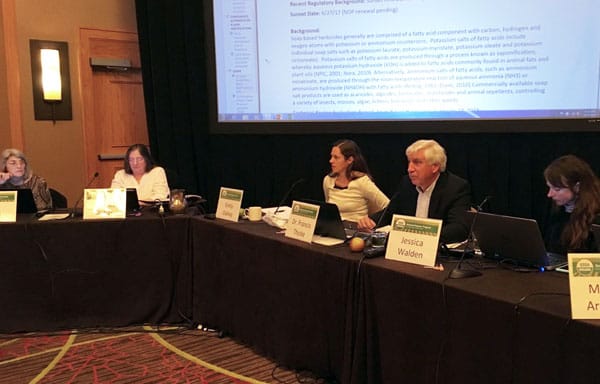 |
9:53AM CT: The NOSB Crops Subcommittee opens the final day of the board’s meeting in Denver. They discuss materials up for 2019 Sunset review. These include Chlorine Materials, Soap-based Herbicides, Biodegradable Plastic Mulch, Boric Acid, Sticky Traps, Copper Sulfate, Fixed Coppers, Humic Acids, Micronutrients, Vitamin B1, C, and E.
The discussion turns to soap-based herbicides, with many public comments both for and against. Proponents say it is the same substance as soap-based insecticides, and those against testified that it is in a much higher concentration and there are concerns about the effects on soil microbiology and earthworms.
Thursday, April 20, 2017
The meeting will resume tomorrow morning.
6:36PM CT: Last item of the day was a discussion concerning the conversion of native ecosystems to farmland. This has negative impacts on biodiversity and the environment. Currently, there is an incentive to convert land that has not been farmed before to organic production because it has not been treated with prohibited chemicals. This means that converting wild lands instead of conventionally farmed land to organic production eliminates the three-year waiting period for conventional lands.
Cornucopia applauds the effort by the NOSB to address this important issue. Over 450 comments were received from the public in support of eliminating this incentive.
Cornucopia’s formal comments noted that a complete prohibition on organic certification of land that has not been previously farmed is the best way to prevent the conversion of high-value land and fragile ecosystems. We suggested using an eligibility period of five years before conversion would de-incentivize the current near immediate conversion of high-value lands.
6:26PM CT: Certification, Accreditation & Compliance Subcommittee discusses challenges for ensuring consistency and integrity in inspection and oversight along with checks and balances.
Regulations require the producer to submit an Organic System Plan (OSP) and be inspected annually by the certifier. The inspector must be evaluated annually by the certifier. The certifier must submit documentation on all aspects of its operations as part of its audit by the USDA every five years (interim audits occur at about two-year intervals) with the NOP auditors evaluated every three years. The National Organic Program is required to have a Peer Review evaluation annually.
The fast growing nature of organic production has created some challenges to ensuring the quality of this extensive process.
The Cornucopia Institute submitted comments in support of the proposal for field review of inspectors once per three years—with some global concerns regarding the performance of contract and employed inspectors. The proposal was sent back to subcommittee unanimously for more review.
6:20PM CT: Livestock Subcommittee starts their initial review of the 2019 sunset materials, including synthetic substances allowed for use in organic livestock production.
Support was expressed for relisting Chlorhexidine, Chlorine Materials, Glucose, Tolazoline, and lidocaine. For oxytocin, CROPP prohibits its use and WhiteWave testified that it is no longer used so it could be removed, although other certifiers commented that it is still used.
In the discussion of copper sulfate used as a foot bath, it was noted that zinc sulfate was added as an alternative but does not have the same effect as copper.
NOSB member Francis Thicke (environmental and an organic dairy farmer) commented that foot baths are not necessary because lame foot can be treated individually. Members want to look at the disposal of copper sulfate in subcommittee.
Cornucopia submitted comments that procaine (a local anesthetic), is not widely available except in combination with the antibiotic penicillin, which is prohibited for use in organic livestock production. Cornucopia noted that lidocaine is a better alternative.
5:35PM CT: The discussion document on the use of BPA (used in packaging) in organic products was supported by most public commenters, including Cornucopia.
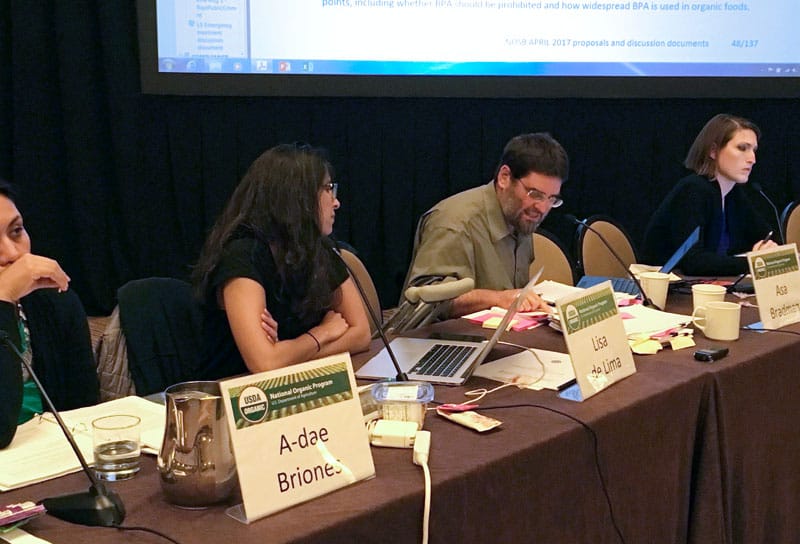 |
Numerous peer-reviewed studies show that BPA is an endocrine-disrupting chemical and is linked to a multitude of adverse health effects, including cancer, obesity, diabetes, neurological and behavioral problems, and reproductive issues.
Comments were also made that there are thousands of potential endocrine-disrupting chemicals used in packaging and that might be beyond the scope of the NOSB. NOSB member Lisa de Lima (retailer) said that consumers on the retail side are concerned about BPA.
NOSB member Joelle Mosso (handler/processor) stated that she works for a company that cans tomatoes without BPA and though there may be other chemicals of concern, today we tackle BPA and in the future we tackle more. The amount of exposure detected in the body is quite high – up to ten times after eating a can of soup, for example.
See Cornucopia’s formal comments for more detail.
5:15PM CT: The proposal addressing the ancillary substances for use with cellulose was referred back to the Handling Subcommittee because there were additional substances found that were not reviewed.
Cellulose is currently listed on the National List for use in regenerative casings, as an anti-caking agent (non-chlorine bleached) and filtering aid.
Ancillary substances are intentionally added to a formulated generic handling substance on the National List. These substances do not have a technical or functional effect in the finished product, and are not considered part of the manufacturing process that has already been reviewed by the NOSB, but some of these substances may remain in the final product in small amounts.
5:03PM CT: Cornucopia supported a proposal on tocopherols (a form of Vitamin E) to encourage the use of non-synthetic and organic tocopherols. It would have set an explicit expiration date for use of the synthetic version so as to incentivize the commercial availability of non-synthetic and/or organic tocopherols. This proposal was sent back to subcommittee because of the high number of public comments and complexity of the issue.
We believe consumers don’t want to buy organic food with non-organic ingredients when organic options are available. More details can be found in Cornucopia’s formal public comments.
4:50PM CT: Short DNA Tracers (used for traceability of an organic product) were petitioned to be added to the National List so that current record keeping practices could be simplified and/or supplemented. The NOSB voted universally not to add short DNA tracers to the National List because they fall within excluded methods and are not allowed in organics.
4:43PM CT: The petition to add the amino acid L-Methionine to enteral pediatric formulas received a unanimous vote to be added to the National List. L-Methioinine is used in nutritionally complete pediatric enteral formulas based on soy protein. Pediatric soy-based enteral formulas would be nutritionally deficient without it.
4:31PM CT: 2019 Handling Sunset materials that are agricultural products but produced non-organically, and that are allowed in organic products because there are not enough organic forms, include: casings, konjac flour, and pectin (non-amidated form).
The use of conventional agricultural casings brought up a broader conversation about incentivizing the commercial availability of organic agricultural products for use in organic processing. It’s a blurry line for NOSB members. An agricultural product for some of these could be made available organically if it was simply removed from the National List, which would incentivize its production in an organic form.
Organic konjac is one that is already commercially available, and the supply may be prevalent enough to for the NOSB to support its sunset and removal from the National List at the fall meeting.
4:09PM CT: The NOSB handling subcommittee began its portion of the meeting looking at materials on the National List that are set for 2019 Sunset. The synthetic handling materials attapulgite, bentonite, diatomaceous earth, nitrogen, sodium carbonate, acidified sodium chlorite, carbon dioxide, chlorine materials, magnesium chloride, potassium acid tartrate, and sodium phosphates were discussed.
There was conversation around the fact that there are five phosphates on the National List and there are general concerns over the cumulative effects of phosphates in diet. They noted that there is debate over whether or not the materials are essential and the amounts in the diet are too small to have a cumulative health effect.
Concern was expressed over the fact that there was testimony indicating a current glut of organic milk in the market, and we might not want to limit diversified markets for organic milk.
This is the first meeting for review of these materials. The NOSB will vote on whether or not to retain them on the National List in the fall.
3:45PM CT: The NOSB public comment has ended, with a rhyme by John Ashby about the importance of the essentiality of the National List.
The handling subcommittee report and issues discussion is the next order of business.
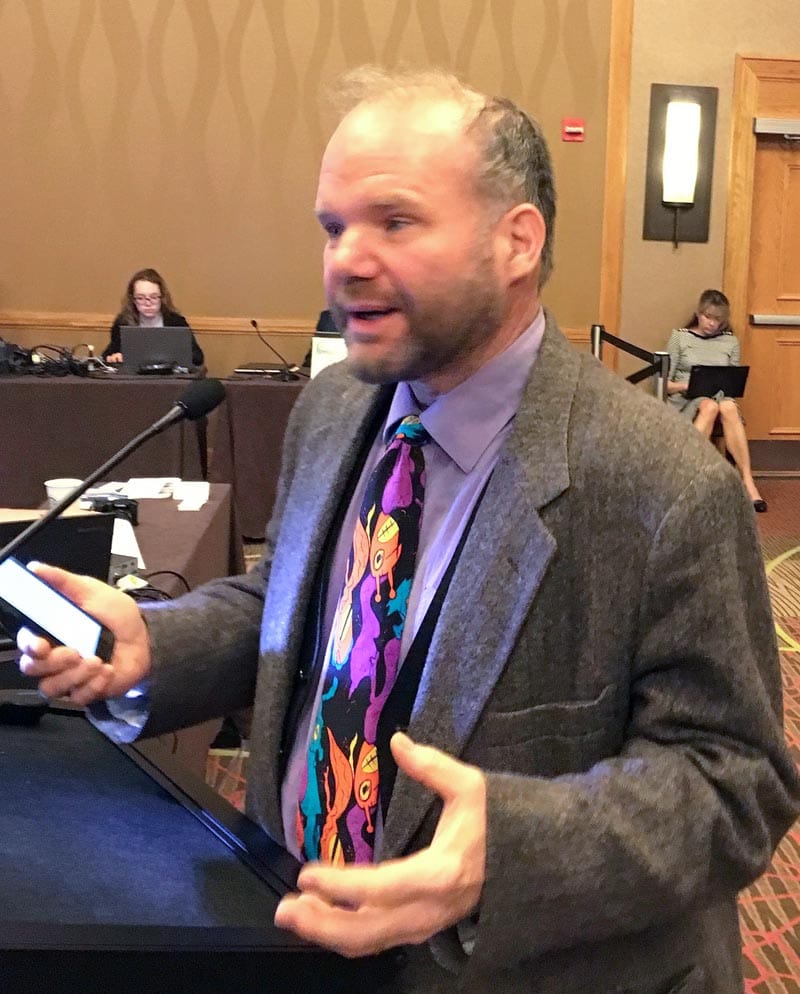 |
Organic Consumers Association |
3:31PM CT: Pat Kerrigan, Organic Consumers Association: Biodiversity conservation is important to organic consumers, and eliminating the incentive to convert native ecosystems to organic production is crucial. OCA supports a new inclusive Biodiversity Enhancement standard in organics.
3:28PM CT: Gwendolyn Wyard, Organic Trade Association: The proposal for seed purity isn’t ready for prime time, please send back to subcommittee. Further guidance on GE contamination is needed. The BPA discussion is challenging because there are thousands of contact points with BPA through processing.
3:19PM CT: Tracy Favre, former NOSB member and current executive director of certifier QAI, recommended that the AFFCO definition of emergency for parasiticide use should be helpful to the NOSB, including the words “unforeseen” and “sudden.” It is important for a livestock operator to be able to respond rapidly, so a veterinarian’s approval is not recommended.
2:54PM CT: Ian Justus, representing Driscoll’s: We need to clarify definitions. No one knows what percent of fertility comes from liquid nutrients. In response to a question from NOSB member Francis Thicke (environmental), Justus says Driscoll’s only grows the nursery plants but they have individual growers that all have different practices. Everyone is using blends of fertility from the National List.
NOSB member Emily Oakley (farmer) asks if they can use 50% compost in the containers.
Justus responds that you need to have a better definition of compost. We need to separate soil from fertility. But 50% is too high for our growers for a compost that supplies fertility. We want to distribute the fertility. Most of the fertility is needed later in life.
1:11PM CT: David Ferman of Coalition for Sustainable Organics and Marketing Director of NS Brands – produce organic hydroponic container tomatoes in Arizona. Consumers believe organic is about healthier products for them and their families, not improving the condition of the soil, he said.
Concerns were expressed by many NOSB board members about who the consumers were and how the questions were asked.
12:49PM CT: Nicole Dehne of Vermont Organic Farmers: Limit container growing to the EU’s approach of grown in the soil in the ground, with limited exceptions such as transplants. Biobased plastic mulches are a synthetic petroleum product, but they are better than the plastic mulches currently in use which are completely not sustainable. Don’t let the perfect be the enemy of the good.
NOSB member Scott Rice (certifier) pointed out that the use of the petroleum products in horticultural oils is common and appreciated her comments.
12:41PM CT: Ed Lehrburger, Pure Hemp Technology LLC: Organic certification of industrial hemp will benefit everyone. We want to label it properly for consumers.
12:38PM CT: Jackie DeMinter of the certifier MOSA: It is important to define emergency use of parasiticides, while also allowing producers to react quickly for the health of the animals and to reduce spread. Regular outbreaks of parasites due to inadequate pasture management does not define emergency.
Guidance is the better route than a rule change because of the complexity of the actions that should have been taken before resorting to parasiticides. MOSA takes guidance very seriously and consistently applies guidance.
NOP’s McEvoy stated that regulations are more enforceable.
12:23PM CT: Jason Kamimoto of Rocket Farms: We use peat moss and turkey fertilizer pellets to grow in containers. We meet the Canadian organic container standards that require minimum soil volumes and limit liquid nutrients.
12:17PM CT: Michael Hasey of The Farming Fish: We grow in the ground, and aquaponically. It is all a very sustainable system that recycles nutrients and should be considered organic.
Cornucopia Note: Cornucopia applauds these sustainable ground-based aquaponic systems. But they are different than organic and should be labeled aquaponic through their own product verified system.
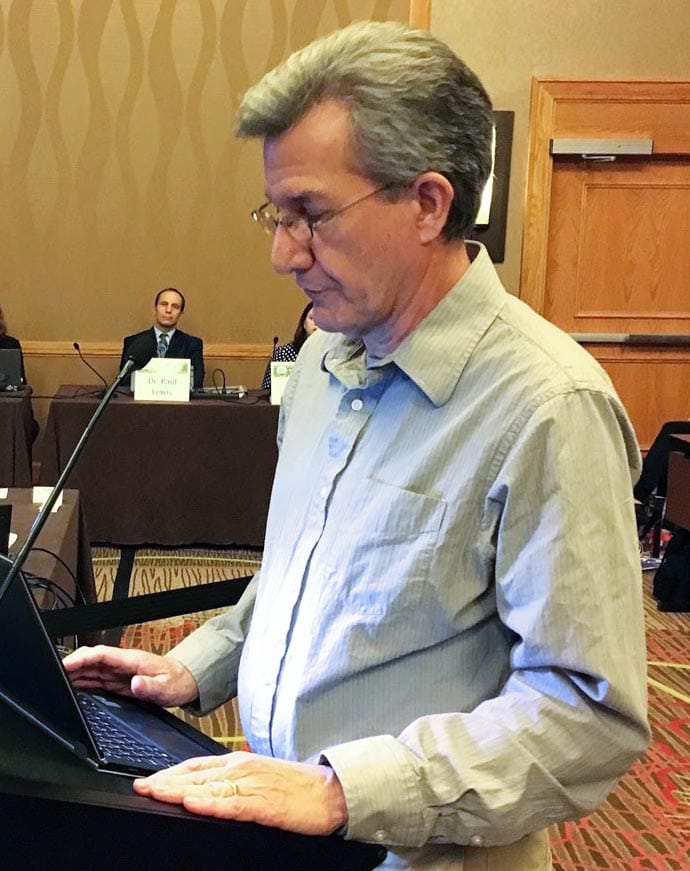 |
One Cert |
11:52AM CT: Sam Welsch, owner of the certification agency One Cert: Federal law, specifically OFPA 6513, requires that an organic plan shall contain provisions designed to foster soil fertility, primarily through the management of the organic content of the soil through proper tillage, crop rotation, and manuring.
When asked by NOSB member Ashley Swaffar how no-till systems fall under “proper tillage,” Welsch replied that no-till is included in proper tillage and fosters soil fertility through the organic content of the soil. It is certainly possible to monitor the quantities of liquid fertilizers applied, to keep them below the 20% amount of total fertility for example, but the standards need to be clear and the actual source of liquid fertility inputs need to be disclosed for traceability.
11:34AM CT: Jason Whitcher, speaking for a distributor of container and soil grown products: Container production uses the same inputs as soil growers, therefore they should be allowed to be organic.
Cornucopia Note: Cornucopia submitted comments that both federal law (the Organic Foods Production Act) and the NOP Final Rule describe organic agricultural production as much more than substituting approved inputs for those not approved. Hydroponic container growers take what organic farmers call “amendments” and use them to provide the majority of the fertility for the crop.
11:24AM CT: Suzanne McMillan, for the American Society for the Prevention of Cruelty to Animals: The painful procedures of tail docking and debeaking can be prevented by enforcing proper stocking densities, balanced genetics, and adequate outdoor access.
11:19AM CT: Kristin Adams of the certifying agent MOSA supports the continued growth of organics through the allowance of aquaponic, aeroponic, hydroponic, and container hydroponic growing.
11:14AM CT: David Hiltz (of Acadian Seaplants) produces products from algae: Does not want to be restricted from using brown, green, or red algae harvesting.
Cornucopia Note: Cornucopia supports the discussion document that lists specific species that are harvested so that the NOSB can create criteria that protects the overharvesting of specific marine algae.
11:10AM CT: Hydroponic supporter Bill Broydrick to the NOSB: Our containers are more sustainable than soil farming, we use fewer fertilizers and less water.
Cornucopia Note: Cornucopia contends that properly managed organic soils act as a sponge and retain water and nutrients, and are therefore more sustainable.
10:59AM CT: Consultant Bill Wolf of Wolf, DiMatteo + Associates: Push the standards always with the intention of increasing earthworms. We must sustainably harvest seaweeds. We should follow the organic standards in Canada, where once an organic supply of something is available, it is required to be used.
10:46AM CT: Richard Wallick expressed concerns about contamination of inputs, like compost. “The NOP must ensure that certifiers do not certify USDA organic products produced using prohibited substances.”
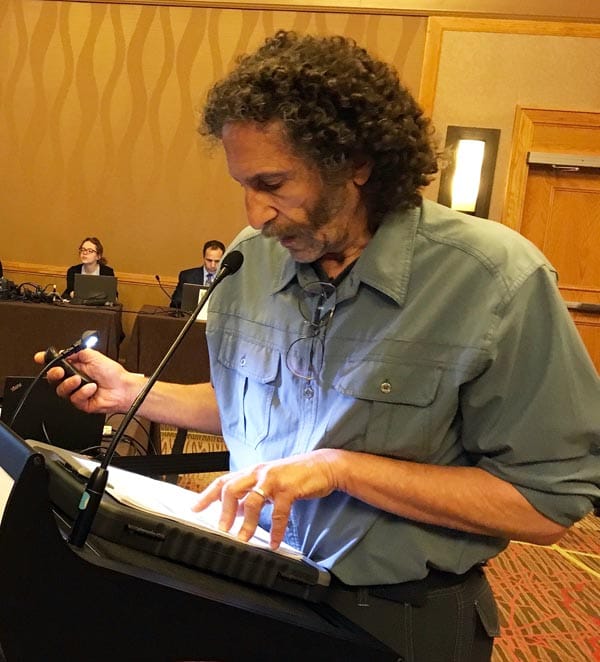 |
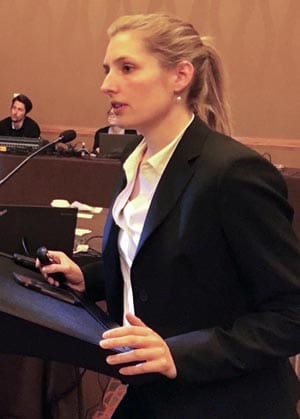 |
Organic Stakeholder |
BASF |
10:27AM CT: Katharina Schlegel, a representative from BASF that sells the biobased plastic mulch, testified that the biobased mulch products on the market are 20% biobased and 80% fossil [fuel] based.
Cornucopia Note: Cornucopia has concerns that there are trace toxins from the fossil [fuel] portion of the mulch that can build up in the soil over time.
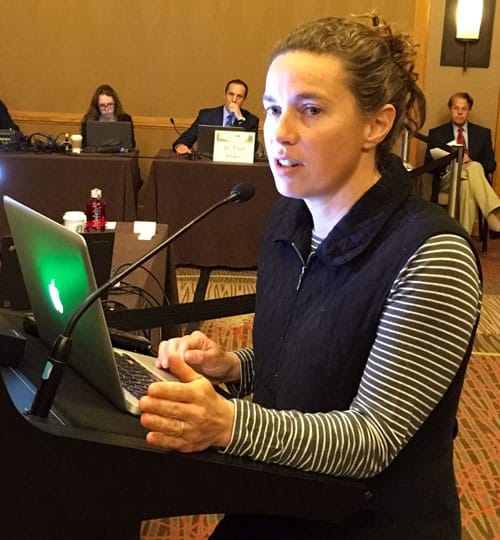 |
Cornucopia |
10:06AM CT: Cornucopia lead scientist Linley Dixon testifies during the NOSB’s morning public comment period, saying: What we need to remember in this room when we are trying to “grow organics” is that there is a massive local food movement sweeping the nation including thousands of farmers adhering to OFPA that can “grow organics” if given the opportunity. Let’s encourage these farmers to get certified by keeping the standards strong.
Wednesday, April 19, 2017
The meeting will resume tomorrow morning.
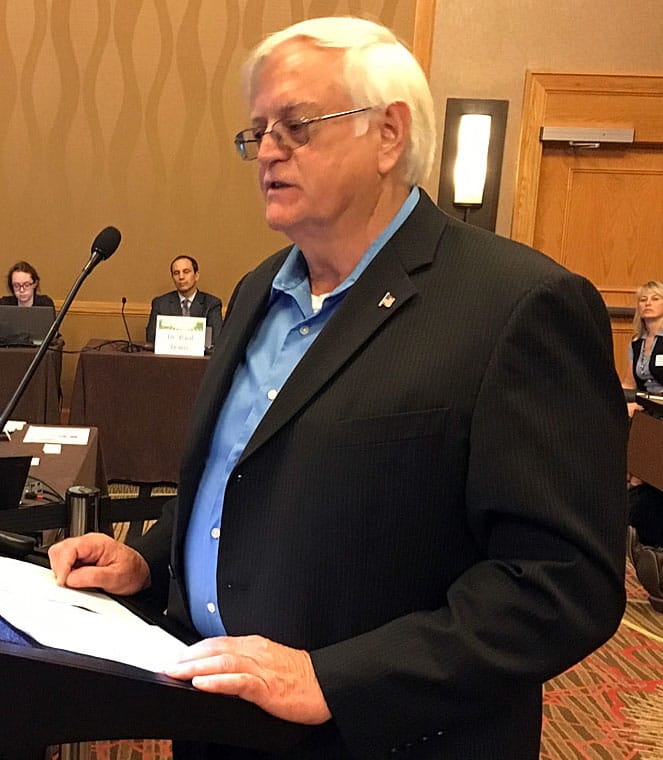 |
Western Organic Dairy Producers Alliance |
7:14PM CT: Richard Mathews, representing the Western Organic Dairy Producers Alliance: The sustainability of organic producers is directly related to the lack of follow-through with the origin of livestock rule. The dairy sector crisis is directly linked to inaction by the NOP. They’ve left us with no option other than to go directly to Congress and to court!
7:10PM CT: Brunno Da Silva Cerozi of Superior Fresh testifies that aquaponics tie the link between animals and plants for nutrient cycling. In soils, a soil solution is required between the root and the soil too. Microbes are involved in delivering the nutrients in both systems.
Cornucopia Note: Cornucopia contends that there is nothing wrong with aquaponic systems, they are just not organic systems.
7:02PM CT: Gerald Davis of Grimmway Farms, former NOSB member: “Reject allowing liquid substrate container farms under the organic label.”
6:50PM CT: Farmer Jeff Dean’s testimony: If my cows get out and eat someone else’s crops, I have to pay for those crops. When GE contaminates crops, the polluter should pay. We must get control of fraudulent organic imports.
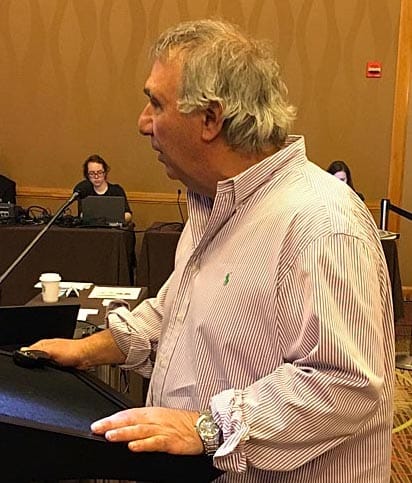 |
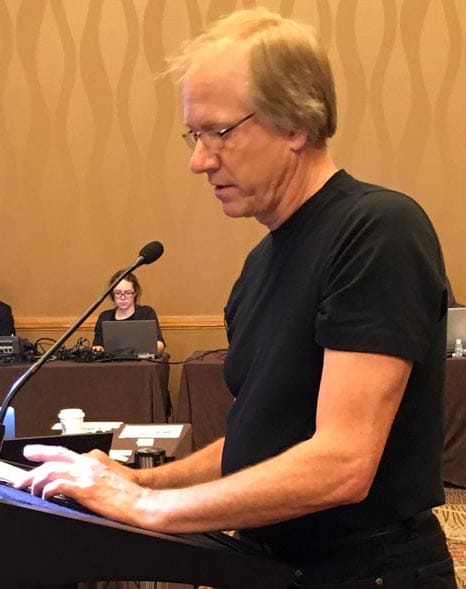 |
Farmer, CCOF |
Farmer |
6:41PM CT: Phil LaRocca, farmer, wine maker, and CCOF board president: “I’ve spent half of my life building soil. Having said that, we would like to see organic hydroponics labeled “hydroponic” under the organic label and let the consumer decide. If I have a choice between a tomato grown in the soil and hydroponic, I would choose the soil. However, if the only choice was organic hydroponic and a conventional soil grown tomato, I would choose the organic hydroponic.”
6:35PM CT: Scott’s Miracle Gro company representative testifies in support of organic hydroponics: “As the world’s population grows, there is the need for new technologies.”
Cornucopia Note: Cornucopia argues the same arguments were made to justify the use of synthetic fertilizers, herbicides, and pesticides.
6:31PM CT: Gail Nelson of G&G Connections: Increased shortages of organic produce are being felt in the marketplace. Hydro organic farming is an innovation in organics that can deliver the needs of the consumer.
6:20PM CT: Albert Straus of Straus Family Creamery: We are losing organic milk sales to non-verified claims. Consumers are confused about other claims such as grass-fed, non-GMO, no rBGH. We need to hold organic as the gold standard that it is.
6:11PM CT: Isaura Andaluz, a board member of OSGATA, delivered a passionate testimony that heritage corn has been contaminated in New Mexico. “The polluter must contain their technology. The polluter must pay.”
6:05PM CT: Nicholas Gardner of International Food Additives Council/Kellen supports konjac flour, non-amidated pectin, and sodium phosphates because organic pectin is not available and phosphates are not harmful to humans.
Several consumer interest groups have testified that the accumulative effect of phosphates in food has been well documented in the literature as a concern. Beyond Pesticides also commented that organic konjac is now available.
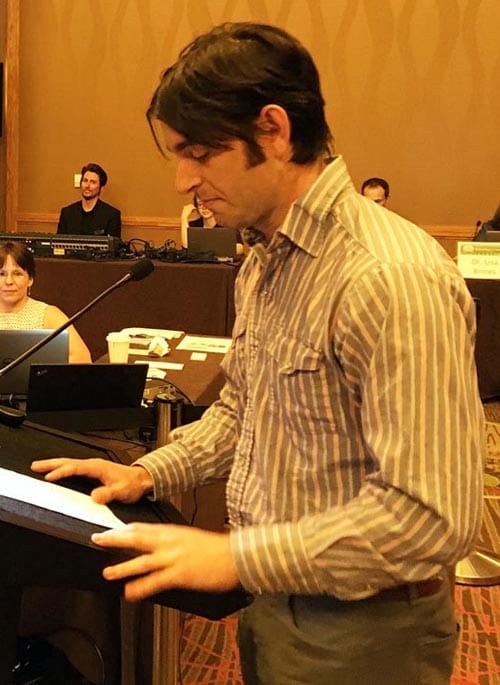 |
Organic Trade Association |
5:55PM CT: Nate Lewis of the industry lobbyist group, the Organic Trade Association: We need to look for consensus and compromise. We support the 2010 recommendation as well as guidelines for container production.
Cornucopia Note: OTA is seeking to redefine hydroponics and remove container production from the common understanding/definition.
5:45PM CT: Manufacturing group ICL Fertilizers tells the NOSB: “Phosphates do not cause human health problems.”
Cornucopia Note: Cornucopia agrees with the testimonies from several consumer non-profits that have testified that phosphates do not meet the human health criterion in federal law (OFPA) and that the prohibition on sodium phosphate in European, Japanese, Codex, and IFOAM organic standards strongly suggests that it is not essential in the production of organic foods.
5:40PM CT: Jo Ann Baumgartner of Wild Farm Alliance: With over 450 comments in support of this issue, the NOSB must act now to get rid of the incentive to convert wild lands into organic production.
NOSB member Emily Oakley (farmer) asks a question: What do you think about a provision that would keep any land that hasn’t been cropped before not allowed to be certified organic?
Baumgartner responds: The value in what you are suggesting is that it would be more simple to enforce, but it excludes CRP land which is a problem, which is why we are proposing a five year eligibility period for “high conservation value areas,” a term which has international recognition.
5:19PM CT: Conventional hydroponic grower Tanimura and Antle tells the NOSB that they have large acreages of conventional hydroponics ready to transition to organic if it is allowed.
5:10PM CT: Wil Hemeker of the University of Akron Research Foundation testifies that all systems are biologically complex, both hydroponic container systems and soil.
Cornucopia Note: Cornucopia contends that all systems, even conventional systems, have biology in their systems, but that doesn’t make them organic. Part of what makes a system organic includes increasing soil fertility, not the continuous feeding of liquid nutrients, regardless of whether or not there is biology in the system.
5:00PM CT: Anais Beddard of Lady Moon Farms, Cornucopia policy advisor: My parents were part of a group of revolutionaries that believe that soil practices such as crop rotations and cover crops provide nutritious healthy products. Organic is not an inputs-based system. We should adopt the EU standards.
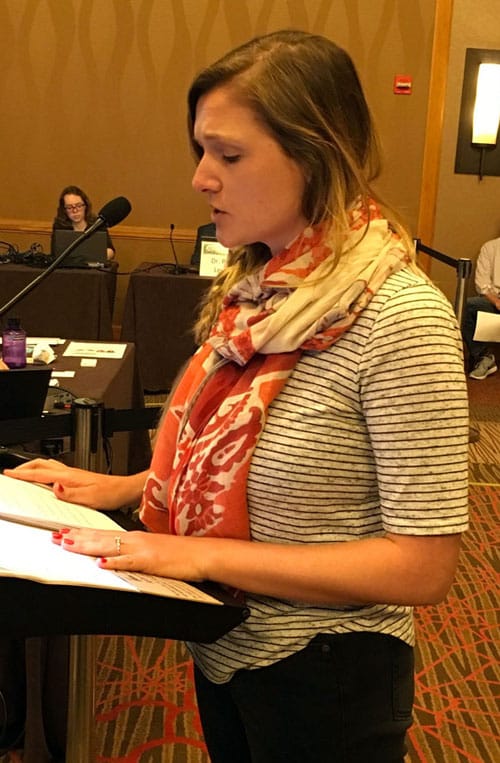 |
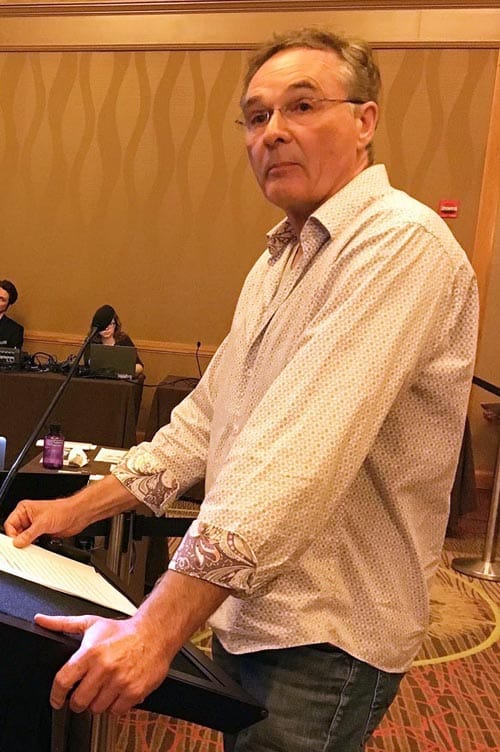 |
Lady Moon Farms |
Lady Moon Farms |
Tom Beddard of Lady Moon Farms: “OFPA got it right. Soil fertility is the benchmark for being an organic farm. An entire complex organic production system centered around the soil is progress, not a simple hydroponic system. Calling hydroponics/containers ‘organic’ is capitulating to market forces. In my experience, you can’t have a container system that doesn’t end up depending almost entirely on soluble fertilizers.”
4:40PM CT: Three employees of Emery Oleochemicals testified in support of ammonium nonanoate, a soap-based insecticide and herbicide. They contend that since ammonium nonanoate is currently allowed as a soap-based insecticide in organic production, “it should also be allowed for use as an herbicide as well.”
Cornucopia Note: Cornucopia contends that the rates for use as an herbicide are higher than those used as an insecticide, and there are risks of harming beneficial insects both on the sprayed weeds and in the soil with its use as an herbicide.
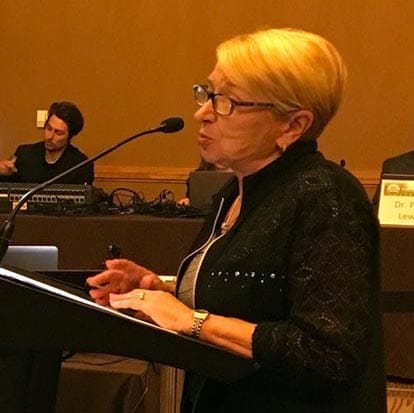 |
Nature’s One |
4:25PM CT: Diane Wilson said Nature’s One is petitioning to add L-methionine to the National List for use in nutritionally complete pediatric enteral formulas based on soy protein.
Cornucopia Note: Cornucopia agrees that L-methionine is an essential amino acid, and pediatric soy-based enteral formulas (for children that have a milk protein intolerances) would be nutritionally deficient without it.
4:22PM CT: David Moore of Neudorff North America: “Fixed coppers are not harmful to humans or the environment.”
Cornucopia Note: Cornucopia contends that coppers are overused and sprayed preventatively in monoculture production systems, where production practices such as wider plant spacing and in-field crop diversity could reduce the number of sprays. Copper products are also among the most hazardous materials for workers used in organic production.
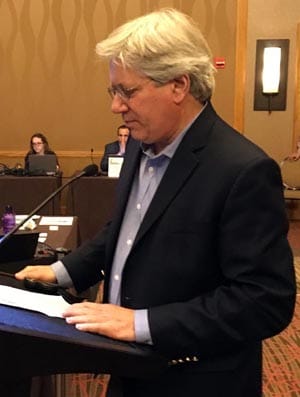 |
Beyond Pesticides |
4:19PM CT: Jay Feldman, former NOSB member and executive director of Beyond Pesticides: The integrity of the organic seal is currently in jeopardy. Feldman mentions a number of problems, including:
- Biobased Plastic Mulch: This product should not be on the National List because there are no products that meet the standard.
- Contaminated Inputs: Regarding drift and contamination through compost, we need an action plan on the discussion document. Please move forward on that.
- Inerts: There is an unconscionable delay on individually reviewing inerts and requesting TRs.
- Hydroponics: There was a previous board decision in 2010, and there is no new information. The NOP should move forward on this.
- Open Docket: This is critical to the success of the NOSB, and it will enrich the involvement of stakeholders in organics.
4:08PM CT: Cameron Harsh, Center for Food Safety: Nanomaterials should not be used in organic, for example as additives in plastic packaging, because they migrate into food. Nano-molybdenum and nano-cobalt are currently used in conventional food products and should be prohibited in organics.
4:05PM CT: Terry Shistar, scientist and board member of Beyond Pesticides: “Many inerts and ancillary substances are toxic, and all should be individually reviewed. The NOSB Handling Subcommittee has not performed the review necessary to support the ancillary substances in cellulose. Some of the substances that the proposal would allow are toxic in any amount including polyvinylidene, vinyl chloride, kymene, and unspecified ‘resin.’”
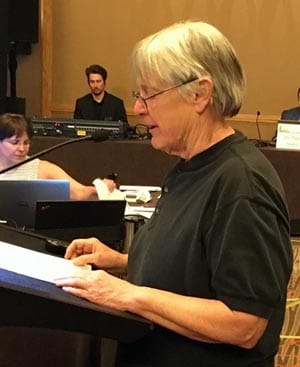 |
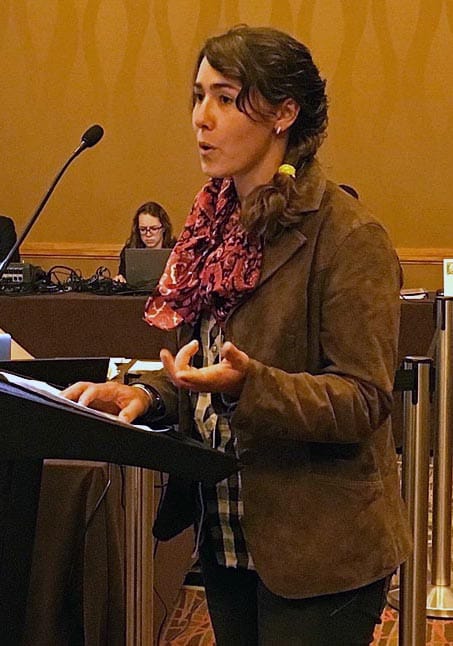 |
Beyond Pesticides |
Farmer |
3:54PM CT: Demetria Stevens, fifth generation farmer from Kansas and OSGATA member: “Genetic contamination of organic crops from GE crops is of big concern for growers and consumers. GE wheat is not commercially available but it has been trialed, and wheat has tested positive for GE in Asia. I grow a landrace wheat that we are concerned will be contaminated as well, especially because we save our seed and I cannot find this seed anywhere else.”
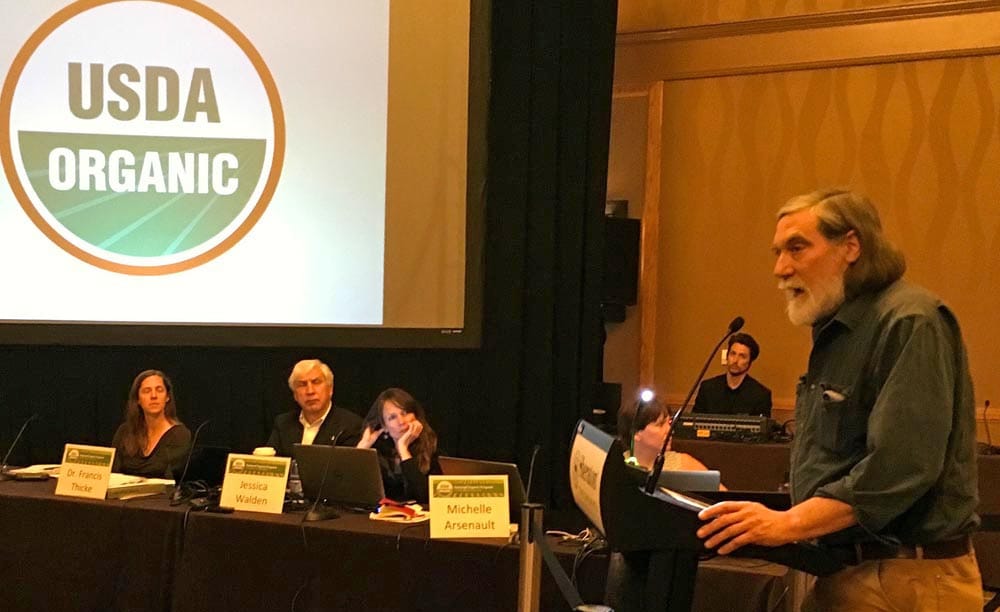 |
3:43PM CT: Jim Gerritsen, an organic potato farmer, Cornucopia policy advisor, and president of OSGATA: “We’ve been certified organic by MOFGA for 35 years. OSGATA’s definition of genetic engineering is that if there’s manipulation at a subcellular level, that is genetic engineering. Organic seed should be 100% free of GE.”
“Soil,” adds Gerritsen, “is the foundation of organic farming and it [hydroponics] doesn’t meet the requirements of OFPA.”
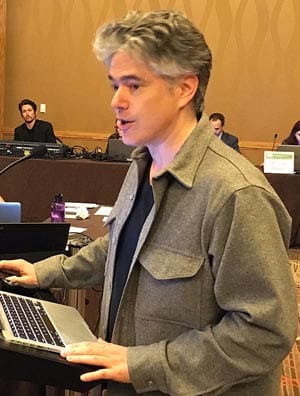 |
Organic Insider |
3:36PM CT: Max Goldberg of the publication Organic Insider: “OFPA requires maintaining soil fertility. Why are we even discussing hydroponics in organics?” Goldberg also urges the NOSB to test glyphosate residues on organic products “as part of the random residue testing program required in organics.”
3:31PM CT: Three individuals from the food additives lobby, CP Kelko, testify that non-organic pectin is required to stay on the National List of approved materials for use in organics because the source for pectin co-mingles organic and conventional agricultural products. They source sugar beet pectin from Europe because it is non-GMO.
3:19PM CT: Alan Lewis of Natural Grocers says that they label organic produce in their grocery stores that is hydroponic so their consumers can choose. “Welcome to the organic minus label. If that doesn’t break your heart, what will?” He also testifies that organic is competing with other labels and organic is losing its gold standard status.
Martin Eddy of the farmers’ cooperative grain marketing organization OFARM: Fraudulent organic imports are a big problem to the survival of U.S. organic grain producers. One ship is 450,000 bushels of grain, the equivalent of 3,000 acres of organic production in one shipment. We suspect that there has been co-mingling with conventional grain.
3:12PM CT: Back from lunch, public testimony resumes with Lisa Trope, a Food and Water Watch, Colorado, employee: “52,000 fracking wells in Colorado use fresh water, and farmers are competing with the oil and gas industry for water. The valley where Paonia is located has many organic farms, and is currently in a fight to protect its water quality from the fracking industry.”
1:58PM CT: Ms. Rosemary Bilchak, an Organic Seed Growers and Trade Association member, tells the NOSB that they are just one organic farm that has been contaminated with pesticides by drift. CDA has failed to do its job. The contamination is so bad that they now can’t be certified organic.
NOSB member Harriet Behar (environmental) agrees we don’t get the protection we deserve, and it is regulated by the states, not by NOP. Ms. Rosemary has said that in some states in the past, the court has said that trespass alone is considered damages, but different states handle it differently.
1:50PM CT: Charlotte Vallaeys of Consumer Reports testifies that sodium phosphate should be removed from the National List of substances approved for use in organics. The widespread use of phosphates in foods has known health concerns because of the accumulative exposure from many foods.
She also reports that animal welfare is an important issue for organic consumers.
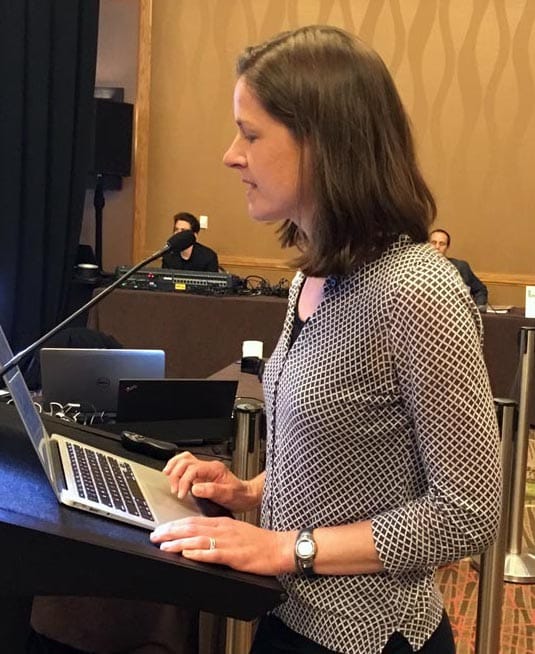 |
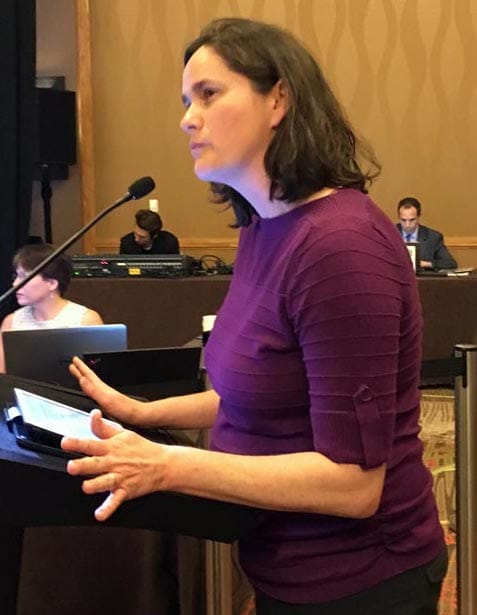 |
Consumer Reports |
National Organic Coalition |
1:48PM CT: Abby Youngblood with the National Organic Coalition comments that the process of peer review is part of what gives us the confidence in the organic seal.
She praised the NOSB for the passing of the organic excluded methods document and noted that we need to be vigilant to keep that updated and enforced.
Hydroponics advocates, she says, have “muddied the waters” by distinguishing between container and hydroponic production, but they both rely on outside inputs. Organic is much more than the inputs.
1:42PM CT: Patty Lovera and citizen lobbyists from Food and Water Watch express concerns that wastewater from the oil and gas industry is entering treatment facilities and then being used for irrigation water with chemicals remaining.
There are only a few studies that even show testing of irrigation water for a few of these chemicals, and some were found to be above drinking level allowances.
NOSB members Emily Oakley (farmer) and Scott Rice (certifier) on the Certification, Accreditation & Compliance subcommittee want help from stakeholders to identify how we can work through the regulatory framework to protect organic food.
1:31PM CT: Madison Monty of NOFA-VT tells the NOSB that he would like to see container standards developed more clearly before containers are allowed to be certified. In the meantime, only ground production can be certified organic in line with the EU.
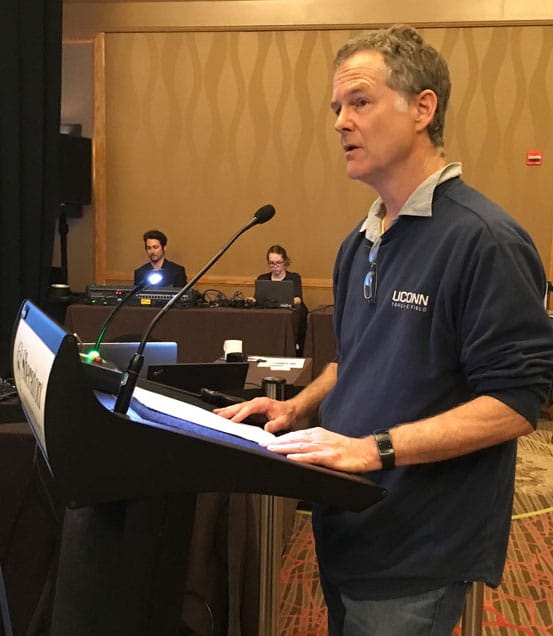 |
Farmer |
1:29PM CT: Dave Chapman, a Vermont farmer, testifies: The hydroponic lobby has called us the “circular firing squad,” but the organic community is largely united with the law that organic is based on soil.
If we do not follow the law, he says, we will lose our place as the healthy soil movement, and we need that association now more than ever. The NOP was created to serve and protect, not to reinvent. You will either tear apart the organic movement or restore it. He recommends that the hydroponic/container lobby follow a similar process-verified system with the USDA so that consumers can be informed of the growing practices.
1:20PM CT: Nanci Burtman, a consumer, says “Farmers from some parts of California use fracking water for irrigation water that contains up to 175 different constituents from fracking. The farmers may not know that the water has been recycled from oil and gas activities.”
NOSB member Emily Oakley (farmer) recommends that we contact the California Water Board for information to clarify whether or not the water includes fracking water or water from “oil and gas activities.”
12:51PM CT: Cornucopia’s Mark Kastel testifies. Our focus is on protecting the foundational ethical precepts in organics, he says.
Kastel adds: I remember, back in the 70s and 80s, one of the mantras in the organic movement was “feed the soil not the plants.”
The focus was on building organic material, biological activity, and nutrients for more nutritious, flavorful food while protecting the earth
Now corporate lobbyists in this room are telling you that feeding plants, continually, with a liquid fertilizer solution, in pure water or sprayed through the air or in containers filled with mostly inert ingredients is …. “organic.”
This is a gross betrayal of the organic movement.
When asked by an NOSB member, Kastel clarified that his comments were not about federal law (OFPA), rather that enforcement is the problem.
12:40PM CT: Christie Badger of the National Organic Coalition expressed concerns that ancillary substances do leave trace substances in the final products and should be reviewed individually because the National List includes some substances that are toxic and should not be used in organic products. She also advocated for organic seed use in organic production, noting that the loophole for use of conventional seed is problematic.
12:32PM CT: Frankel’s astroturf group, Coalition for Sustainable Organics, includes roughly 40 growers. The group formed a little over a year ago when the NOSB started to question whether containers should be considered organic during the discussions of the NOP Hydroponics Task Force.
When asked by NOSB member Harriet Behar (environmentalist) whether their growers’ container systems could include standards that require soil, Frankel responded that growers could throw a pinch of soil in the system, but that doesn’t necessarily indicate whether that would be a best practice.
12:29PM CT: Public comment period begins at NOSB meeting.
First up, Theo Crisantes, a grower for Wholesome Harvest, a giant hydroponics producer. Crisantes says he has been certified organic for 10 years in containers filled with coco coir.
Lee Frankel, Coalition for Sustainable Organics, the hydroponic container astroturf group, says there is biology in their systems; therefore they are organic.
Cornucopia Note: Many hydroponics growers use containers, growing the roots in a soil-less and inert media such as coco coir or peat moss. This soil-less technique is used by Driscoll’s, Wholesum Harvest, and other large growers.
11:11AM CT: The NOP highlighted a few ways in which organic imports are problematic.
Currently organic imports that are fumigated because of APHIS (Animal and Plant Health Inspection Service) requirements should not keep their organic status, but that has been a weakness in the system.
The NOP is working on requiring import certificates from countries that the U.S. does not have equivalency agreements with, but currently that is also a weakness in the system.
10:53AM CT: The Organic Livestock and Poultry Practices Rule has been delayed until May 19, 2017 because of the new USDA administration. The rule is said to be targeted by the new administration because 80-90% of the organic eggs currently in the marketplace will not be in compliance with the new requirements.
Organic trade is expanding and fraudulent certificates continue to be identified. We have an ongoing investigation into the increase in organic corn and soy imports from Turkey and other regions. “Alleged violations in foreign countries can be complex and challenging to investigate and enforce.”
10:37AM CT: The NOP is getting significantly more complaints than they are able to handle. In the last half year, the NOP has received over 180 complaints, but closed only 1/3 of them. Miles McEvoy: “This is not a sustainable system.”
10:31AM CT: Miles McEvoy provides an overview of the AMS NOP’s personnel and responsibilities. “Our mission is to ensure the integrity of USDA organic products and provide clear standards.”
Cornucopia contends that one way that the NOP has harmed organic integrity by allowing the certification of hydroponic operations despite clear recommendations from the NOSB in 2010 that hydroponics is not inline with the OFPA.
10:20AM: Miles McEvoy, deputy administrator of the AMS NOP, opens the NOSB meeting. NOSB members introduce themselves, including five new members, Asa Bradman (environmental/conservation seat), Joelle Mosso (handler/processor seat), Steve Ela (farmer seat), Sue Baird (consumer/public interest seat), and Dave Mortensen (scientist seat).
